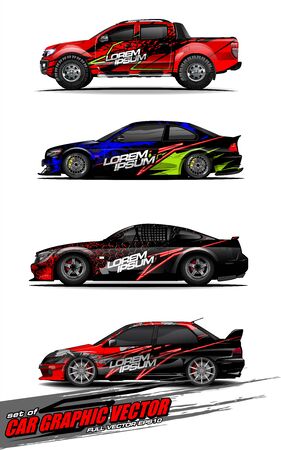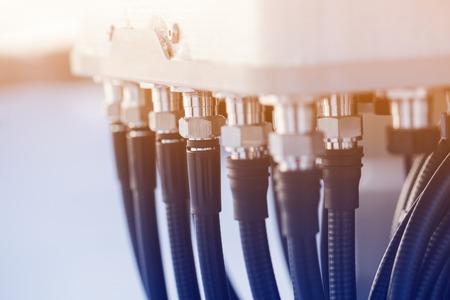1. Introduction to Forced Induction and Exhaust Systems
Forced induction systems, such as turbochargers and superchargers, are designed to increase an engine’s power output by forcing more air into the combustion chamber. The design of the exhaust system plays a critical role in the efficiency and performance of these systems. A well-designed exhaust system can maximize power, improve throttle response, and enhance overall engine efficiency.
Overview of Turbochargers
A turbocharger uses exhaust gases to spin a turbine, which then drives a compressor to force more air into the engine. This process increases power without requiring a larger displacement engine. However, the effectiveness of a turbocharger is heavily influenced by exhaust system design.
How Exhaust Design Affects Turbochargers
- Exhaust Flow Efficiency: A restrictive exhaust system can slow down the flow of gases, causing turbo lag and reducing performance.
- Backpressure: Too much backpressure in the exhaust system forces the turbo to work harder, decreasing overall efficiency.
- Piping Diameter and Routing: Properly sized pipes and smooth routing help maintain optimal exhaust velocity, improving turbo response.
Overview of Superchargers
A supercharger, unlike a turbocharger, is driven by a belt connected to the engine’s crankshaft. It provides immediate power without lag, making it ideal for performance applications. While superchargers do not rely on exhaust gases, the exhaust system still plays a role in maintaining engine efficiency.
How Exhaust Design Affects Superchargers
- Reduced Backpressure: A well-designed exhaust system ensures that exhaust gases exit quickly, improving overall engine breathing.
- Heat Dissipation: Supercharged engines generate significant heat, and a good exhaust setup helps dissipate excess thermal energy.
- Optimal Exhaust Scavenging: Proper scavenging techniques help remove remaining exhaust gases, allowing for cleaner air-fuel mixtures in the next combustion cycle.
Comparison of Turbochargers and Superchargers in Relation to Exhaust Systems
| Aspect | Turbochargers | Superchargers |
|---|---|---|
| Power Delivery | Boost builds with exhaust flow, causing some lag | Instant boost without lag |
| Exhaust Dependence | Relies on exhaust flow for power | Not directly dependent on exhaust gases |
| Impact of Exhaust System | Critical for performance and efficiency | Plays a supporting role |
In conclusion, the exhaust system’s design significantly impacts turbocharged and supercharged engines in different ways. For turbocharged engines, optimizing exhaust flow is crucial, while for superchargers, reducing backpressure and improving heat management play a bigger role. Understanding these factors helps in designing performance-oriented forced induction systems.
2. Backpressure and Its Effects on Forced Induction Engines
What Is Backpressure?
Backpressure refers to the resistance that exhaust gases encounter as they exit the engine through the exhaust system. While some level of backpressure is naturally present in all engines, excessive backpressure can negatively impact performance, especially in turbocharged and supercharged engines.
How Backpressure Affects Turbocharged Engines
Turbocharged engines rely on exhaust gases to spin the turbine, which in turn compresses incoming air for increased power. If backpressure is too high, it can slow down the exhaust flow, reducing the turbine’s efficiency and causing turbo lag. On the other hand, if backpressure is too low, it can hurt low-end torque.
How Backpressure Affects Supercharged Engines
Unlike turbochargers, superchargers are mechanically driven and don’t rely on exhaust gases. However, high backpressure in a supercharged engine can still create additional resistance for exhaust flow, reducing efficiency and power output.
Comparison of Exhaust Design and Backpressure Effects
| Exhaust Design | Effect on Backpressure | Impact on Forced Induction |
|---|---|---|
| Stock Exhaust | Moderate to High | Can limit performance but helps with emissions and noise control |
| High-Flow Exhaust | Lower | Improves turbo spool and engine efficiency |
| Straight-Pipe Exhaust | Minimal | Maximizes power but may reduce low-end torque |
| Aftermarket Downpipe | Reduced | Enhances turbo response and overall performance |
Optimizing Exhaust Design for Forced Induction
A well-designed exhaust system should balance backpressure to improve both power and efficiency, particularly in turbocharged and supercharged setups. High-flow exhaust components, such as larger diameter piping and free-flowing mufflers, can help minimize unnecessary restrictions while keeping the right amount of backpressure for optimal performance.

3. Exhaust Flow Dynamics and Spool Time
How Exhaust Gas Velocity Affects Turbo Spool
Exhaust gas velocity plays a crucial role in turbocharged engines. When exhaust gases exit the combustion chamber at high speed, they hit the turbine wheel with greater force, helping the turbo spool up faster. A faster spool time means reduced turbo lag and quicker power delivery. However, if the exhaust velocity is too low due to excessive pipe diameter or inefficient routing, the turbo may struggle to build boost efficiently.
Pipe Diameter: Finding the Right Balance
The diameter of the exhaust piping directly affects gas velocity. If the pipes are too large, the exhaust gases expand and slow down, which can reduce turbo response. Conversely, if the pipes are too small, they can create excessive backpressure, restricting flow and limiting power output. Finding the right balance is essential for optimal turbo performance.
| Pipe Diameter | Exhaust Gas Velocity | Impact on Turbo Spool |
|---|---|---|
| Too Small | High | Excessive backpressure, reduced power |
| Optimal | Balanced | Faster spool time, efficient power delivery |
| Too Large | Low | Slower spool, increased turbo lag |
Optimal Exhaust Routing for Efficiency
Exhaust routing is another critical factor that affects turbo performance. The smoother and more direct the exhaust flow, the less turbulence and restriction the gases face. Avoiding sharp bends, reducing unnecessary pipe length, and using mandrel-bent tubing help gases maintain speed and energy, improving turbo spool time.
Impact on Supercharged Engines
Even though superchargers are mechanically driven and dont rely on exhaust flow for boost, the exhaust system still plays a role in overall efficiency. A restrictive exhaust can increase engine load, reducing available power for the supercharger drive system. By optimizing exhaust flow, supercharged engines can operate more efficiently and maximize power output.
4. Four, Catalytic Converters, Mufflers, and Performance Considerations
The Role of Catalytic Converters and Mufflers in Forced Induction Setups
When modifying or designing an exhaust system for turbocharged and supercharged engines, balancing emissions compliance and performance is essential. Two critical components that influence this balance are the catalytic converter and the muffler. These components help meet environmental regulations while also affecting exhaust flow, backpressure, and overall engine efficiency.
Catalytic Converters: Emissions Control vs. Exhaust Flow
Catalytic converters (commonly called “cats”) are required in most modern vehicles to reduce harmful emissions. They use a combination of precious metals like platinum, palladium, and rhodium to convert toxic gases into less harmful emissions. However, in forced induction setups, catalytic converters can introduce exhaust flow restrictions, which may negatively affect performance.
Types of Catalytic Converters
There are different types of catalytic converters available, each with its own trade-offs in emissions control and exhaust flow:
| Type | Features | Pros | Cons |
|---|---|---|---|
| OEM Catalytic Converter | Designed for strict emissions compliance | Meets legal requirements, long lifespan | Higher exhaust restriction, reduces performance |
| High-Flow Catalytic Converter | Less restrictive than OEM versions | Improves exhaust flow while still reducing emissions | May not meet all legal emissions standards |
| Catless Downpipe | No catalytic converter, straight-through exhaust | Maximum performance and exhaust flow | Illegal in most areas, higher emissions |
Mufflers: Noise Reduction vs. Performance
While mufflers are primarily designed to reduce exhaust noise, they also impact airflow and backpressure. Choosing the right muffler can help maintain performance while keeping sound levels within legal limits.
Types of Performance Mufflers
There are different muffler designs for various performance needs:
| Type | Features | Pros | Cons |
|---|---|---|---|
| Chambered Mufflers | Uses internal chambers to cancel sound waves | Effective noise control, deep exhaust tone | May create more backpressure |
| Straight-Through (Glasspack) | Perforated tube design with fiberglass packing | Better exhaust flow, aggressive sound | Less effective at reducing noise |
| Turbo Mufflers | Multi-pass design for noise reduction | Balanced sound and performance | Moderate backpressure |
Finding the Right Balance
For turbocharged and supercharged engines, selecting the right combination of catalytic converter and muffler is crucial. High-flow catalytic converters and straight-through mufflers are popular among performance enthusiasts since they offer a good balance of emissions compliance, sound control, and performance gains. However, local emissions laws and noise regulations must always be considered when modifying an exhaust system.
5. Optimizing Exhaust System Design for Power and Efficiency
When dealing with turbocharged and supercharged engines, optimizing the exhaust system is crucial for maximizing horsepower, torque, and overall efficiency. A well-designed exhaust system can improve turbo response, minimize backpressure, and enhance engine scavenging. Here are some best practices for tuning various exhaust components to achieve peak performance.
Selecting the Right Exhaust Pipe Diameter
Choosing the correct exhaust pipe diameter is essential to maintain proper exhaust gas velocity and minimize restrictive airflow. A pipe that is too small causes excessive backpressure, while an overly large pipe may reduce exhaust gas velocity, impacting turbo spool-up and efficiency.
| Engine Horsepower | Recommended Exhaust Pipe Diameter |
|---|---|
| 200-350 HP | 2.5 inches |
| 350-500 HP | 3 inches |
| 500-700 HP | 3.5 inches |
| 700+ HP | 4 inches or larger |
Optimizing Downpipe Design
The downpipe plays a crucial role in directing exhaust gases away from the turbocharger. A wider and smoother flowing downpipe reduces backpressure and enhances turbo spool-up. Using mandrel bends instead of crush bends ensures less turbulent airflow, leading to improved efficiency.
Choosing Between High-Flow Catalytic Converters and Test Pipes
For street-driven vehicles, a high-flow catalytic converter balances performance and emissions compliance. However, for track applications, a test pipe (where allowed by law) can maximize exhaust flow, reducing restrictions and improving turbo response.
Importance of a Well-Designed Muffler
Mufflers impact both sound and performance. A straight-through, perforated-core design minimizes restrictions while maintaining an aggressive exhaust tone. Avoid chambered mufflers as they can introduce unnecessary turbulence and hinder exhaust gas flow.
Using an Equal-Length or Tuned-Length Header
For supercharged applications, an equal-length or tuned-length header can improve exhaust scavenging, ensuring better cylinder filling and contributing to overall efficiency and power gains.
Adding a Proper Wastegate Dump or External Dump Tube
In turbocharged setups, an external dump tube for the wastegate can reduce unwanted turbulence in the main exhaust flow, preventing pressure build-up and enhancing boost control.
Final Thoughts on Exhaust System Tuning
By carefully selecting and optimizing each exhaust component, turbocharged and supercharged engines can achieve improved power delivery, better throttle response, and increased efficiency. Every modification should be tailored to the specific engine setup and performance goals to maximize results.


